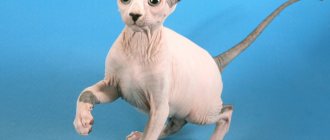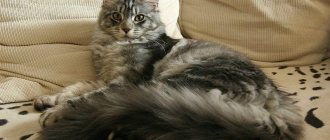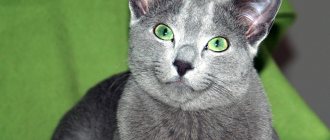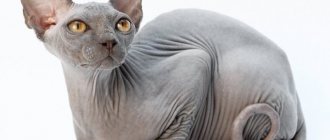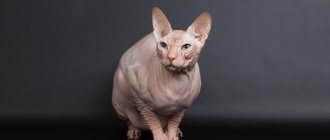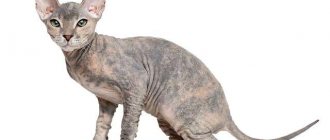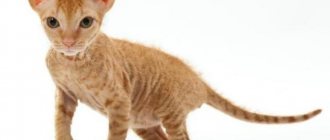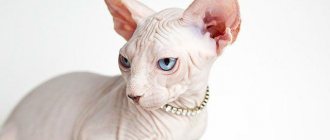Don Sphynxes are an amazing modern breed. These household members are very easy to care for and do not require special maintenance conditions. The only thing you need to know is some of the features of this breed so that your pet is always well-groomed and healthy. These cats attract attention with their unusual appearance.
It’s as if they came to us from another galaxy. Reactions to these cats vary from delight to hostility. But more often it’s surprise, and then charm. The main feature of this breed is that cats have no hair.
But there are exceptions, there are “brush” and “flock” cats, they have a little hair. In this article we will talk about some nuances in care that will help your household always look great.
Description of the Don Sphynx breed
Popularity 66th place among 86 cat breeds
Lifespan:
12-15 years
Height:
25-30 cm
Country of origin:
Russia
Average price:
15-30 thousand rubles
Weight:
males: 5-7 kg, cats: 3.5-5 kg
Latest articles Cat care
How to trim a cat's claws correctly and easily 01/28/2022 139 0 0
Dog health
How to do an ultrasound for dogs: preparation and procedure 01/28/2022 63 0 0
Key facts
The abbreviated name of the breed is Donchak. Bald animals got their name thanks to their homeland - Rostov-on-Don.
The life expectancy of the Don Sphynx is 12-15 years. Representatives of this breed have poor health, but there have been cases when pets lived up to 30 years. The main disadvantage of Donchak is its vulnerability to low temperatures. The poor thing is constantly freezing and practically never leaves his owner’s hands. Due to the lack of fur, heat immediately spreads throughout the body, so the Don cat seems very hot.
Despite the slightly alien and slightly arrogant appearance, the main characteristics of the Don Sphynx breed are good nature and peacefulness. In their character, these pets are in many ways reminiscent of dogs: they also painfully endure the loss of their beloved owner.
The description of the Don Sphinx is a bit reminiscent of the Canadian one. Their main difference is the gene responsible for the lack of hair. Among Canadians it is recessive, which greatly interferes with their breeding, but among Donetsk it is dominant.
What is the price
A purebred Don Sphynx kitten with a pedigree costs from 15 to 35 thousand rubles. This breed is still rare. You should not pay attention to offers to buy such a pet cheaper. For 5000-10000 you can buy a cat without a pedigree or with fake documents. She may have congenital pathologies or character defects.
The Don Sphynx is a companion cat with a calm, peaceful character. It is ideal for families with small children, and due to the lack of wool, it is recommended to have this breed for allergy sufferers. This is an animal with an original appearance that is sure to attract attention. He requires attention and careful daily care. But in return, the pet will give a lot of love and will help cope with stress.
History of the origin of the Don Sphinx
Russia is recognized as the country of origin of the breed. It was here in the winter of 1986 that a resident of the Rostov region saved a stray kitten from the hands of hooligans.
The rescued animal turned out to be a girl. The owner called her Varvara and began to nurse her. Despite the care, the cat soon began to go bald on her back. She was taken to doctors, but they just threw up their hands. Judging by the tests, the animal was absolutely healthy.
Only 2 years later, Varvara, with the pitiful remains of her former fur coat, was examined by felinologists, but did not make an impression on them. She was noticed only in 1990, when, after mating with a shorthaired European cat, she gave birth to one practically hairless kitten. The baby, named Chita, interested the breeder Irina Nemykina. The woman took the future founder of the breed with her and began breeding experiments.
Chita was balder than Varvara, but some hair was present on her paws and tail. Subsequent matings with short-haired partners did not give the desired results. The fur did not disappear. Then Nemykina decided to resort to inbreeding, that is, mating close relatives.
Her efforts paid off. The first completely hairless kitten was a baby named Basya Mif. In 1996, hairless wards received official recognition and their name.
Due to the small number of Donchaks, until 2000 they continued to be bred with European Shorthairs, Russian Blues, Siamese and Angoras. One of these experiments led to the formation of another breed - the Peterbald.
What not to feed the Sphynx
The following foods are prohibited for Sphynx cats:
- fatty foods;
- sausages, sausages and smoked products;
- bones (injure the esophagus);
- River fish;
- fried foods;
- sweets, baked goods, flour;
- mushrooms;
- citrus fruits, all types of grapes, avocados, since they cause severe allergies;
- onion and garlic.
Sphinxes are strictly prohibited from drinking alcoholic beverages, coffee and other drinks containing stimulants.
Animal food must be stored in a designated place and be fresh. In the worst case, spoiled food will lead to negative consequences.
What does the Don Sphynx look like?
After looking at the photo of the Don Sphynx, one gets the impression that he has a lot in common with Egyptian cats. The size of representatives of this breed reaches 25-30 cm in height at the withers. How much a Donchak should weigh depends on gender - boys are always larger. They reach 5-7 kg. The weight of girls is more modest and amounts to 3.5-5 kg.
Muzzle
The breed is characterized by a wedge-shaped head with pronounced cheekbones and a strong-willed chin. On the rounded muzzle there is a straight nose, connected to the wrinkled forehead by a pronounced stop. On the top of the head are large, widely set ears, rounded at the tips.
The Donchak has slightly slanted, almond-shaped eyes that lack eyelashes. Short vibrissae are twisted into a spiral. They often break off, and sometimes they don’t grow back at all. Defects of the breed include a narrow or rounded head, too small ears, inversion of the eyelids and an underbite of more than 2 mm.
Body type
The low and thin neck goes into a dense and muscular body, expanding in the croup and chest. The front limbs of the Doncha are shorter than the hind limbs. They end in strong and powerful paws with elongated toes. The flexible, whip-like tail tapers to a tip. An abundance of folds is characteristic of the neck, armpits, paws, abdomen, groin area and tail.
Skin and color
The elastic skin of the Don people is completely bald or covered with soft down. Depending on the type and structure of the existing fur, there are 4 varieties of the Don Sphynx:
- Brush
. The most unusual species with sparse curly fur. The length of its hairs is the maximum. Such animals are not allowed for exhibitions, but are used for breeding. With age, the number of curly hairs decreases.
- Flock
. The body is covered with “peach fuzz”, which gradually disappears.
- Velours
. Unlike flocks, the fluff of a velor cat is longer and thicker. It also disappears as they grow older, but sometimes the coarsest hairs remain on the head and paws.
- Hollowborn
. The fur is completely absent. The skin is covered with many wrinkles and is slightly sticky to the touch due to a special secretion. It is secreted by the sebaceous glands to protect against infections.
Among the colors of the Don Sphynx, any colors are allowed except lilac and chocolate. Due to the lack of fur, these cats rarely cause allergies in people.
Colors
The colors of hairless cats are varied. But due to the lack of wool, they do not look very bright. The colors themselves can be divided into several groups - solid, points, and patikolours. Solid or solid colors include:
- White. This color is found in all breeds. Don Sphynxes with this coloring may have cream shades than pure white.
- Black. In color painting it is called seal point. Black individuals have varying degrees of skin pigmentation. It can be from dark black to gray. When determining color, you need to examine the paw pads, nose and ear rims. Eyes can be any color.
- Blue. This color is a lightened version of black. May appear as baby blue or light grey.
- Red. This color cannot exist without tabby coloring. Newborn red kittens are often confused with cream kittens.
- Cream. Lightened version of red.
Tortoiseshell colors are unique to cats and there are several types of tortoiseshells:
- black tortoise is a combination of black and red colors;
- The blue turtle is a combination of cream and blue.
White sphinx.
Black Sphinx.
Blue Don Sphynx.
Red Sphinx.
Cream Sphynx.
Tortoiseshell color.
An important condition for determining the color of a turtle is the ability to distinguish it from a tabby-torby. The tortoiseshell color is a combination of black, red or cream. There are also other types of colors of Don Sphynxes:
- Chocolate. This variant is black in color, in the eastern group it is called “Havana”. This type of color is rare and atypical for Donetsk residents.
- Particolors. There are some variations of this color, calico and bicolor. This type is a tortoiseshell color with a combination of white. More than half should be white. Bicolors are a mixture of the main coat color and white. The proportion can be 9 to 1.
- Color points. These colors are found in all cat breeds and the Don Sphynx is no exception. It is a mixture of three or more colors in varying proportions.
- Tabby. Can be classic, spotted black, brindle.
The Don breed does not have different patterns on its body. It is extremely difficult to see them on naked animals.
Material on the topic: popular colors of the Scottish cat breed.
The character of the Don Sphynx
The friendliness of the Donchak cannot be ignored. This cat is hospitable to strangers and does not mind sitting in their arms upon first meeting. He will never scratch or bite his playmate, so you can safely leave him with small children.
Also, a bald pet does not mind playing with other pets. His social circle is not limited even to rodents and birds. Donchak immediately understands that small pets are family members just like him, which means they must be treated with care and love.
The character of the Don Sphynx is moderately lazy. He shows the greatest activity in childhood, and with age he becomes balanced. Despite this, the Donchak will never refuse to play with his beloved owner.
Representatives of this breed have developed intelligence. Their dexterous long fingers skillfully open door locks and kitchen cabinets. Animals are also able to detect the owner’s mood and health problems.
A tame pet never imposes its communication if it sees that a person is busy. But in case of illness, he will definitely lie down on the sore spot and warm it with his warmth, trying to alleviate the condition of the sick person.
Sphinxes and man
Sometimes they are annoying - they vitally need communication and affection, but at the same time they feel the mood of the owner. They are well trained: they quickly get used to the potty, the daily routine, they are amenable to training - they will be happy to learn a few simple tricks.
A strong biofield and amazing energy have earned the pets of the breed fame for their healing properties. Whether this is true or not is not known, but in Ancient Egypt it was hairless cats that were considered healers of ailments. According to Sphynx lovers, one touch to the velvety skin has a beneficial effect not only on mood, but also helps relieve fatigue.
Many consider the Don Sphynx to be a hypoallergenic cat breed for people, but it is impossible to say for sure how true this statement is. It is advisable to get close to him for several days before getting a bald pet forever.
Raising the Don Sphynx
The upbringing of a Donchak begins from the first days of his appearance in the house. At first, the baby may attack his hands, scratch furniture and chew his slippers. This behavior can quickly be eliminated if you understand how to properly raise a cat.
Prevent any unwanted actions with a loud sound (clapping your hands), spraying water or hissing. A sharp noise and suddenly appearing liquid frighten the animal, distracting it from its mischief. Over time, the pet notices the relationship and stops misbehaving.
Full training, including teaching basic commands and simple tricks, is possible, but will require effort. To achieve results, you will have to interest your bald pet. He is capable of a lot, but will not perform any actions without the desire. In this case, a game form of learning works best.
Donchak people quickly understand how to use not only a litter box, but also an ordinary human toilet. Despite the ingenuity, relief from need does not always go smoothly. Even a well-mannered pet can begin to mark its territory. The only plus is that the tags are odorless.
You will have to deal with unwanted behavior using the same techniques, adding oilcloth to the “latrine”. Its specific smell is unpleasant for the cat, so it will quickly forget the way to the restricted area.
Sphynx cats hate grooming. Washing, drying and trimming nails turns into a real test of strength. For more adequate behavior of your pet, try to accustom him to hygiene procedures from early childhood. Otherwise, only a professional groomer can handle it, but the cat’s psyche will still be crippled.
Looking for the Don Sphynx? Find your pet from 1 offer As a gift
Health of the Don Sphynx
The poor health of the Don Sphynx is explained by breed diseases resulting from the experiments of breeders. Also, these cats are dependent on temperature changes, which complicates their safe keeping. Despite these disadvantages, Don Chaks are considered healthier than Sphynx dogs.
Possible diseases
Interbreeding and intrabreeding have led to the frequent occurrence of microphthalmia, a congenital reduction in the eyeball. This pathology reduces visual acuity and increases tear production. The disease cannot be treated, so if pain occurs, the eyes are amputated.
Another disease that occurs at birth is entropion. Unlike microphthalmos, the pathology is eliminated surgically.
Cats with tortoiseshell, light blue and bluish-cream colors are often diagnosed with mammary cysts and nipple hyperplasia. These pathologies are transmitted from the mother, so it is recommended to exclude pets with this diagnosis from breeding.
Among the dental problems among Donetsk people, carp overbite occurs. This is a congenital disorder in the structure of the lower jaw, which turns out to be shorter than normal. Because of this, while eating, the animal can injure the palate with its teeth.
Exposed skin is vulnerable to frost and sun rays. Animals often get colds and sunburn. Due to the resulting irritation, eczema or other dermatological disease may appear in the damaged area.
Reproductive health
Donchak females are characterized by rare estrus and fairly easy childbirth. Pregnancy lasts 63-72 days. Newborns quickly open their eyes or are born sighted. The appearance of the offspring changes up to 1-2 years, so matings are carried out no earlier than this age.
Any variety of Donchak dogs is allowed for mating. The ban is imposed only on inbreeding, interbreed mating and mating of two bare-born individuals. Kittens from such matings often die and are born with abnormalities or very poor health.
Sexual activity in Donetsk dogs manifests itself early - at 6-8 months. When keeping pets of different sexes together, animals develop even faster. After reaching sexual maturity, they can be castrated or sterilized. These procedures serve to prevent many diseases, so veterinarians recommend surgery on all pets that are not involved in breeding.
Estrus and mating
Puberty in female Don Sphynx occurs at the age of six months. But mating has not yet been carried out. An individual is suitable for producing offspring only after the third heat. Males mature at approximately 8 months.
Attention! It is recommended to plan the first mating no earlier than the Don Sphynx turns 1.5-2 years old. It is advisable for the females to go into third heat.
Vaccinations are given before mating. The time for the procedure is calculated so that estrus begins no earlier than 14 days after the vaccine is administered. The female is not bathed before mating, as the male may lose interest in her. Experts warn that if both partners mate for the first time, pregnancy may not occur. It is advisable that mating takes place on the cat's territory. To increase the likelihood of fertilization, the couple is brought together again after a few days.
Signs of pregnancy appear 20 days after sexual intercourse. The female's nipples swell, turn bright pink, and her weight gradually increases. A cat bears offspring for 64 days, but this period may be slightly longer or shorter. Childbirth lasts about a day. One lambing can bring up to 6 babies.
Features of feeding and diet
The cost of keeping the Don Chak is high due to its appetite. To heat up, a bald body requires more energy, so the metabolism works at an accelerated pace. An adult animal will have to be fed 3-4 times a day.
The basis of the diet is meat. A cat should eat 150 g of meat products per day. Twice a week the meat is exchanged for boiled offal, and twice a month - for boiled sea fish, cleaned of bones. The rest of the natural diet consists of the following products:
- cereals;
- vegetables;
- fermented milk products.
All food must be fresh. If you don't have time to cook, then use dry food. Many manufacturers have special lines designed for Sphynx cats. For your pet’s health, choose super premium or holistic food. They contain higher quality ingredients and do not cause stomach upset.
Diet
The majority of the diet should consist of proteins and carbohydrates - this is the main requirement for proper nutrition of the Don Sphynx. In addition to them, there must be vitamins, proteins, minerals, macro-microelements. Nutrition can be provided with ready-made food or natural food. Natural nutrition should consist of meat. This is the best source of protein. It is better to choose chicken, veal, and rabbit meat. Fatty varieties should be excluded. By-products can be used - kidneys, liver, chicken hearts. Scars can be given no more than once a week. Cereals, raw or boiled vegetables are used as additional nutrition for meat.
Care and maintenance
Despite the lack of shedding, Sphynx cats are not as easy to care for as it seems at first glance. People with disabilities may not be able to handle this breed. To avoid troubles, before purchasing, be sure to read the rules for the care and maintenance of the Don Sphynx:
- Bathe your pet frequently with special shampoos for hairless cats. Washing is carried out every 2 weeks or even more often. This is necessary to remove the odorous secretion abundantly secreted by the sweat glands. To prevent skin rashes, use baths with herbal infusions, heating the water to 39-40 °C.
- Wipe your skin daily with a soft cloth soaked in warm water. You can also use regular wet wipes if they do not contain alcohol. Cleansing is carried out in the days between bath procedures to prevent brown secretions from accumulating on the body.
- Use pH-neutral lotions on the tail and spinal column. In these places there is an increased concentration of sebaceous glands, which provokes the appearance of pimples and blackheads.
- Rinse your eyes daily to avoid accumulation of secretions. If greenish or yellowish nitrous appears, contact your veterinarian immediately.
- Clean ear wax weekly using lotion or a cotton pad soaked in water.
- Don't forget to trim your nails and brush your teeth. Donchak dogs do not know how to retract their claws completely, so they can accidentally injure their playmate. To cleanse the mouth, use veterinary paste with fish or meat flavor.
Hairless pets love sunbathing, but do not know the concept of “measure.” Ultraviolet overdose affects their color. If you notice a change in shade, prohibit the cat from lying on the windowsill. Burnt skin will take a very long time to peel off, so it is better to wrap your pet in a warm sweater in advance.
Sphynx care
Breed of hairless cats Don Sphynx: care
Caring for the Don Sphynx and a kitten of this breed should be special. It is unacceptable for an animal to be kept on the street; the cat lives only in a warm apartment.
Since its fur does not warm it, the Don Sphynx is sensitive to cold. In winter, they heat the apartment well or buy clothes for the cat. The skin of this breed is sensitive to ultraviolet rays, so in the summer you should not get carried away with sunbathing: cats can get burned.
The Don Sphynx needs to be bathed regularly once a week. Without water treatments, the cat's skin becomes sticky and damp, irritation and growths appear, which are complicated by dermatitis. The temperature of the water should not be lower than 38°C, the bath is well heated beforehand. After water treatments, the cat is wrapped in a warm blanket. Instead of bathing, sometimes they wipe the cat with a damp cloth.
Be sure to read:
Hairless cats: popular breeds, characteristics, external features, how to care for and feed
Claws should also be trimmed regularly; fortunately, Don Sphynxes are non-aggressive and tolerate this procedure well. Cats do not have eyelids, so they often become inflamed. To avoid this, they are wiped with clean warm water, a decoction of chamomile or calendula, and special antiseptics.
Ears are also cleaned regularly, once every 7-10 days or every time after bathing. Wipe the ears with a damp cotton swab or cotton swab.
Tips for choosing a kitten
It is recommended to buy Don Sphynx kittens no earlier than 3-4 months. At an early age, animals are very weak and can die if left without a mother.
It is better to choose a future pet from a licensed nursery. Such institutions confirm the health of their pupils with veterinary passports and are ready to provide all other documents upon the first request of the buyer.
At your first consultation with staff, ask to see the babies' mother and father. Usually the character of the parents is passed on to all offspring.
Also evaluate the appearance of the animals. What is important here is not only compliance with the standard, but also the absence of painful symptoms. Neither parents nor children should have any flaking, runny nose, cough or bloated belly.
If you want to choose a more affectionate pet, then take a girl. Boys are more independent, but also more playful. Also, their skin has an intense smell of fresh milk with spicy spices.
How to choose a kitten
It is better to buy a Don Sphynx kitten after 3 months. Until this age, they are sickly and weak, and there is a risk of death. It is recommended to choose a responsible breeder or purchase a kitten from a cattery. You should not buy such a pet at the market or from your hands, it will be cheaper, but there is a risk of getting a sick animal with developmental defects.
When choosing, you need to talk to the owner and watch the mother. Usually, children's character and temperament are passed on from their parents. You must have all the necessary documents, a veterinary passport. By this age, kittens should be vaccinated. The living conditions of the animals are also important; it is advisable that the kids are already accustomed to the tray.
You need to choose a kitten carefully. Attention is drawn to several characteristics.
- First of all, examine the baby's skin. There should be no peeling, ulcers, or traces of eczema. Gray plaque may indicate poor living conditions or disease. And the white scars are from the operations performed. Perhaps the kitten has congenital pathologies.
- The baby's appearance must correspond to the breed characteristics. If you take an animal for breeding and participation in exhibitions, you need to choose a hairless or velor type.
- A healthy baby's gums are pink, his teeth are white and straight. Eyes and ears without discharge, clean.
- It is better to avoid kittens with loose bellies, festering eyes, signs of diarrhea and crusts near the anus. A responsible breeder will not offer sick animals for sale, if there are any in the litter, it is better to choose another nursery.
- It is not recommended to adopt a kitten that is cowardly or aggressive. He must make contact, be actively interested in everything that is happening around him, and willingly support the game.
Please note: Not everyone takes into account the gender of the pet when purchasing, although the character and behavior depend on this. Cats are independent, active, can mark territory, and their skin sometimes smells. Cats are more clean, affectionate and sociable.
At the age of 3 months, kittens are already independent, they know how to use a tray, a scratching post, and they know how to eat themselves. You just need to give the baby time to get used to the new conditions. It is advisable to find out from the breeder what to feed the Don Sphynx kitten. It is not recommended to suddenly change the usual diet; first you need to give him what he is used to. Feed a baby up to 6 months 4-6 times a day.
When you bring a kitten into your home, you need to provide it with comfortable and safe conditions. He should have a warm house, bowls for water and food, a scratching post, and lots of toys. Sphynx kittens are very active and curious, so it is better to hide the wires, remove all small objects, household chemicals, and indoor plants. The pet can climb into cabinets, the washing machine and other unexpected places.


